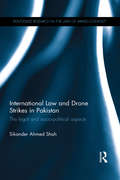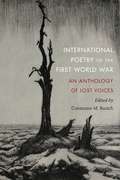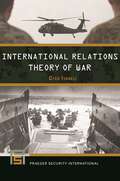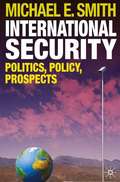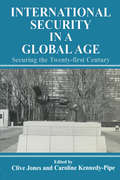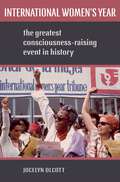- Table View
- List View
International Law and Drone Strikes in Pakistan: The Legal and Socio-political Aspects (Routledge Research in the Law of Armed Conflict)
by Sikander Ahmed ShahWhile conventional warfare has an established body of legal precedence, the legality of drone strikes by the United States in Pakistan and elsewhere remains ambiguous. This book explores the legal and political issues surrounding the use of drones in Pakistan. Drawing from international treaty law, customary international law, and statistical data on the impact of the strikes, Sikander Ahmed Shah asks whether drone strikes by the United States in Pakistan are in compliance with international humanitarian law. The book questions how international law views the giving of consent between States for military action, and explores what this means for the interaction between sovereignty and consent. The book goes on to look at the socio-political realities of drone strikes in Pakistan, scrutinizing the impact of drone strikes on both Pakistani politics and US-Pakistan relationships. Topics include the Pakistan army-government relationship, the evolution of international institutions as a result of drone strikes, and the geopolitical dynamics affecting the region. As a detailed and critical examination of the legal and political challenges presented by drone strikes, this book will be essential to scholars and students of the law of armed conflict, security studies, political science and international relations.
International Law in the Transition to Peace: Protecting Civilians under jus post bellum (Post-Conflict Law and Justice)
by Carina LamontThis book proposes a normative framework specifically designed for the complex and legally uncertain time period between armed conflicts and peace. As such, it contributes both to the furthering of a jus post bellum framework, and to enhanced legal clarity in complex and legally uncertain environments. This, in turn, contributes to strengthened protection engagements, and thus to improved prospects of enabling sustainable peace and security in both national and international perspectives. The book offers a novel but persuasive argument for a legal framework specific for transitional environments. Such legal framework, it is argued, is warranted in order to enable legal clarity to contemporary and outstanding legal issues, as well as to furthering peace efforts in complex environments. The legal framework suggested proposes a dividing line between applicable legal frameworks that, it is submitted, enhances both legal clarity on protection engagements and the quest for sustainable peace. The framework proposed is founded on a legal analysis of the protective nature and function of law. It thus provides a rare but important perspective on law that is of value in the quest for sustainable peace and security. The research draws uniquely on both contemporary legal debates, and on peace and conflict research. It does so in order to enable legal analysis that is both legally sound, as well as appropriate and adequate in today’s peace and security realities. The book provides a valuable resource for academics, researchers and policy-makers in the areas of Public International Law, International Humanitarian Law, International Human Rights Law, (the law of) Peace Operations, and Peace and Security Studies.
International Law in the Transition to Peace: Protecting Civilians under jus post bellum (Post-Conflict Law and Justice)
by Carina LamontThis book proposes a normative framework specifically designed for the complex and legally uncertain time period between armed conflicts and peace. As such, it contributes both to the furthering of a jus post bellum framework, and to enhanced legal clarity in complex and legally uncertain environments. This, in turn, contributes to strengthened protection engagements, and thus to improved prospects of enabling sustainable peace and security in both national and international perspectives. The book offers a novel but persuasive argument for a legal framework specific for transitional environments. Such legal framework, it is argued, is warranted in order to enable legal clarity to contemporary and outstanding legal issues, as well as to furthering peace efforts in complex environments. The legal framework suggested proposes a dividing line between applicable legal frameworks that, it is submitted, enhances both legal clarity on protection engagements and the quest for sustainable peace. The framework proposed is founded on a legal analysis of the protective nature and function of law. It thus provides a rare but important perspective on law that is of value in the quest for sustainable peace and security. The research draws uniquely on both contemporary legal debates, and on peace and conflict research. It does so in order to enable legal analysis that is both legally sound, as well as appropriate and adequate in today’s peace and security realities. The book provides a valuable resource for academics, researchers and policy-makers in the areas of Public International Law, International Humanitarian Law, International Human Rights Law, (the law of) Peace Operations, and Peace and Security Studies.
The International Law of Peacebuilding: Engaging the Conflict Resolution and Peace Community (Studies in Conflict, Development and Peacebuilding)
by Omar GrechThis book contributes to the debate on the international law of post-conflict peacebuilding and suggests a need for closer connections between practitioners and lawyers.The work argues that significant benefits accrue when lawyers and conflict/peace practitioners, and scholars work with each other to develop a normative framework for building peace. It also attempts to bridge the divisions that exist between lawyers and the conflict resolution/peace community in the specific context of the international law of post-conflict peacebuilding. After introducing the key concepts of the international law of peacebuilding, the book explores aspects of the relationship between lawyers and peacebuilding practitioners and offers ideas about how this relationship might be improved. It then proceeds to identify some principles and processes developed by conflict resolution specialists that may inform and influence discrete parts of the international law of peacebuilding. The work concludes by identifying sites and ways in which international lawyers and conflict resolution/peace specialists may engage with each other to shape this branch of international law.This book will be of much interest to students of peace and conflict studies, international law and International Relations.
The International Law of Peacebuilding: Engaging the Conflict Resolution and Peace Community (Studies in Conflict, Development and Peacebuilding)
by Omar GrechThis book contributes to the debate on the international law of post-conflict peacebuilding and suggests a need for closer connections between practitioners and lawyers.The work argues that significant benefits accrue when lawyers and conflict/peace practitioners, and scholars work with each other to develop a normative framework for building peace. It also attempts to bridge the divisions that exist between lawyers and the conflict resolution/peace community in the specific context of the international law of post-conflict peacebuilding. After introducing the key concepts of the international law of peacebuilding, the book explores aspects of the relationship between lawyers and peacebuilding practitioners and offers ideas about how this relationship might be improved. It then proceeds to identify some principles and processes developed by conflict resolution specialists that may inform and influence discrete parts of the international law of peacebuilding. The work concludes by identifying sites and ways in which international lawyers and conflict resolution/peace specialists may engage with each other to shape this branch of international law.This book will be of much interest to students of peace and conflict studies, international law and International Relations.
International Mediation in a Fragile World
by David Carment Evan HoffmanContributions to this volume consider the importance of mediation in violent conflict. Practical and applied, this publication will be of interest to scholars, academics, policymakers and practitioners. It was originally published as a special issue of Canadian Foreign Policy Journal.
International Mediation in a Fragile World
by David Carment and Evan HoffmanContributions to this volume consider the importance of mediation in violent conflict. Practical and applied, this publication will be of interest to scholars, academics, policymakers and practitioners. It was originally published as a special issue of Canadian Foreign Policy Journal.
International Military Operations in the 21st Century: Global Trends and the Future of Intervention (Cass Military Studies)
by Tore Nyhamar Per M. Norheim-MartinsenThis book examines the challenges that military forces will face in multinational operations in the 21st century. Expanding on Rupert Smith’s The Utility of Force, the volume assesses the changing parameters within which force as a political instrument is ultimately carried out. By analysing nine carefully selected mission types, the volume presents a comprehensive analysis of key trends and trajectories. Building upon this analysis, the contributors break the trends and parameters down into real and potential tasks and mission types in order to identify concrete implications for military forces in future multinational operations. The context of military intervention in conflicts and crises around the world is rapidly evolving. Western powers’ shrinking ability and desire to intervene makes it pertinent to analyse how the cost of operations can be reduced and, how they can be executed more intelligently in the future. New challenges to international military operations are arising and this book addresses these challenges by focusing on three key areas of change: 1) An increasingly urbanised world; 2) The changing nature of missions; 3) The commercial availability of new technologies. In answering these questions and embracing some of the insights of a growing field of future studies, the volume presents an innovative perspective on future international military operations. This book will be of much interest to students of international intervention, military and strategic studies, war and conflict studies, security studies and IR in general.
International Military Operations in the 21st Century: Global Trends and the Future of Intervention (Cass Military Studies)
by Per M. Norheim-Martinsen Tore NyhamarThis book examines the challenges that military forces will face in multinational operations in the 21st century. Expanding on Rupert Smith’s The Utility of Force, the volume assesses the changing parameters within which force as a political instrument is ultimately carried out. By analysing nine carefully selected mission types, the volume presents a comprehensive analysis of key trends and trajectories. Building upon this analysis, the contributors break the trends and parameters down into real and potential tasks and mission types in order to identify concrete implications for military forces in future multinational operations. The context of military intervention in conflicts and crises around the world is rapidly evolving. Western powers’ shrinking ability and desire to intervene makes it pertinent to analyse how the cost of operations can be reduced and, how they can be executed more intelligently in the future. New challenges to international military operations are arising and this book addresses these challenges by focusing on three key areas of change: 1) An increasingly urbanised world; 2) The changing nature of missions; 3) The commercial availability of new technologies. In answering these questions and embracing some of the insights of a growing field of future studies, the volume presents an innovative perspective on future international military operations. This book will be of much interest to students of international intervention, military and strategic studies, war and conflict studies, security studies and IR in general.
International Poetry of the First World War: An Anthology of Lost Voices
by Constance RuzichRanging far beyond the traditional canon, this ground-breaking anthology casts a vivid new light on poetic responses to the First World War. Bringing together poems by soldiers and non-combatants, patriots and dissenters, and from all sides of the conflict across the world, International Poetry of the First World War reveals the crucial public role that poetry played in shaping responses to and the legacies of the conflict. Across over 150 poems, this anthology explores such topics as the following: · Life at the Front · Psychological trauma · Noncombatants and the home front · Rationalising the war · Remembering the dead · Peace and the aftermath of the war With contextual notes throughout, the book includes poems written by authors from America, Australia, Austria-Hungary, Belgium, Canada, France, Germany, Great Britain, India, Ireland, Italy, New Zealand, Russia, and South Africa.
International Poetry of the First World War: An Anthology of Lost Voices
Ranging far beyond the traditional canon, this ground-breaking anthology casts a vivid new light on poetic responses to the First World War. Bringing together poems by soldiers and non-combatants, patriots and dissenters, and from all sides of the conflict across the world, International Poetry of the First World War reveals the crucial public role that poetry played in shaping responses to and the legacies of the conflict. Across over 150 poems, this anthology explores such topics as the following: · Life at the Front · Psychological trauma · Noncombatants and the home front · Rationalising the war · Remembering the dead · Peace and the aftermath of the war With contextual notes throughout, the book includes poems written by authors from America, Australia, Austria-Hungary, Belgium, Canada, France, Germany, Great Britain, India, Ireland, Italy, New Zealand, Russia, and South Africa.
The International Politics of Space
by Michael SheehanThe year 2007 saw the fiftieth anniversary of the Space Age, which began with the launching of Sputnik by the Soviet Union in October 1957. Space is crucial to the politics of the postmodern world. It has seen competition and cooperation in the past fifty years, and is in danger of becoming a battlefield in the next fifty. The International Po
The International Politics of Space: International Relations Theory And The Politics Of Space (Space Power And Politics Ser.)
by Michael SheehanThe year 2007 saw the fiftieth anniversary of the Space Age, which began with the launching of Sputnik by the Soviet Union in October 1957. Space is crucial to the politics of the postmodern world. It has seen competition and cooperation in the past fifty years, and is in danger of becoming a battlefield in the next fifty. The International Po
International Relations and the Origins of the Pacific War
by Ko UnokiInternational Relations and the Origins of the Pacific War takes the unique approach of examining the history of the relationship between Japan and the United States by using the framework of international relations theories to search for the origins of the Pacific War, that erupted with Japan's attack on Pearl Harbour in 1941.
International Relations Theory of War (Praeger Security International)
by Ofer IsraeliCovering 1816–2016, this book deals extensively with the international system as well as the territorial outcomes of several key wars that were waged during that time period, providing an instructive lesson in diplomatic history and international relations among global powers.Based on an in-depth review of the leading theories in the field of international relations, International Relations Theory of War explains an innovative theory on the international system, developed by the author, that he applies comprehensively to a large number of case studies. The book argues that there is a unipolar system that represents a kind of innovation relative to other systemic theories. It further posits that unipolar systems will be less stable than bipolar systems and more stable than multipolar systems, providing new insights relative to other theories that argue that unipolar systems are the most stable ones. The first chapter is devoted to explaining the manner of action of the two dependent variables—systemic international outcome and intra-systemic international outcome. The second chapter presents the international relations theory of war and its key assumptions. The third chapter precisely defines the distribution of power in the system. The fourth chapter examines the theory's two key phenomena. The fifth and last chapter presents the book's conclusions by examining the theoretical assumptions of the international relations theory of war.
International Relations Theory of War (Praeger Security International)
by Ofer IsraeliCovering 1816–2016, this book deals extensively with the international system as well as the territorial outcomes of several key wars that were waged during that time period, providing an instructive lesson in diplomatic history and international relations among global powers.Based on an in-depth review of the leading theories in the field of international relations, International Relations Theory of War explains an innovative theory on the international system, developed by the author, that he applies comprehensively to a large number of case studies. The book argues that there is a unipolar system that represents a kind of innovation relative to other systemic theories. It further posits that unipolar systems will be less stable than bipolar systems and more stable than multipolar systems, providing new insights relative to other theories that argue that unipolar systems are the most stable ones. The first chapter is devoted to explaining the manner of action of the two dependent variables—systemic international outcome and intra-systemic international outcome. The second chapter presents the international relations theory of war and its key assumptions. The third chapter precisely defines the distribution of power in the system. The fourth chapter examines the theory's two key phenomena. The fifth and last chapter presents the book's conclusions by examining the theoretical assumptions of the international relations theory of war.
International Sanctions: Between Wars and Words (Cass Series on Peacekeeping)
by Carina Staibano Peter WallensteenThe main theme of the book is that the new types of sanctions constitute a challenge to the international system. First, there are more of the targeted sanctions, including financial, travel, aviation, special commodity and arms sanctions. Furthermore, there are considerable but varied practices in implementation. Also there are now sanctions by new actors (regional bodies, international organizations). These all put new strains on international bodies in carrying out sanctions or getting member states to work together in these efforts. These challenges are analyzed in this volume, with some examples, but mostly from a generalist perspective. A completely novel aspect is that this volume also includes studies of the difficulties that are met by targeting actors, their way of managing the situations, and most interesting, the human rights of such actors.
International Sanctions: Between Wars and Words (Cass Series on Peacekeeping)
by Peter Wallensteen Carina StaibanoThe main theme of the book is that the new types of sanctions constitute a challenge to the international system. First, there are more of the targeted sanctions, including financial, travel, aviation, special commodity and arms sanctions. Furthermore, there are considerable but varied practices in implementation. Also there are now sanctions by new actors (regional bodies, international organizations). These all put new strains on international bodies in carrying out sanctions or getting member states to work together in these efforts. These challenges are analyzed in this volume, with some examples, but mostly from a generalist perspective. A completely novel aspect is that this volume also includes studies of the difficulties that are met by targeting actors, their way of managing the situations, and most interesting, the human rights of such actors.
International Security: Politics, Policy, Prospects (PDF)
by Michael E. SmithFrom war, terrorism and weapons of mass destruction, through environmental and economic crises, to epidemics, cyber-war and piracy, the twenty-first century world seems beset by a daunting range of international security problems.
International Security Issues in a Global Age: Securing the Twenty-first Century
by Clive JonesThis volume examines the new, the changing, and the enduring features of international security in the post-Cold War era. In so doing, it examines the extent to which present state structures and institutions have been able to adapt and accommodate themselves to the diversity of security threats.
International Security Issues in a Global Age: Securing the Twenty-first Century
by Clive Jones Caroline Kennedy-PipeThis volume examines the new, the changing, and the enduring features of international security in the post-Cold War era. In so doing, it examines the extent to which present state structures and institutions have been able to adapt and accommodate themselves to the diversity of security threats.
International Security Studies and Technology: Approaches, Assessments, and Frontiers (New Horizons in International Relations series)
International Security Studies and Technology applies an interdisciplinary perspective to the study of emerging technologies and issues related to their development, governance, laws, ethics, understanding, and (mis)use, considering their impact on international security and established international norms.Bringing together a diverse collection of experts, Tobias T. Gibson and Kurt W. Jefferson analyse international security and technology through three conceptual frameworks: approaches, assessments, and frontiers. The book examines the real-life impacts of new technologies on national security, warfare, military doctrine, and geopolitical security alliances across various environmental and human security contexts. Exploring intelligence, information control strategies, cybersecurity, child labour trafficking and chemical and biological weapons, it builds a deeper understanding of the applied aspects of security and technology. The book concludes with a discussion of how science fiction and the silver screen, the future of space in international security, the ethics of autonomous weapons, and American presidential war powers are all affected by the boundaries of technological advancements in the context of international security.This book is vital for students and scholars of security, international relations, AI and technology, politics and public policy, and regulation and governance. Its practical applications are also beneficial to international security lawyers and policy advisors.
International Warbirds: An Illustrated Guide to World Military Aircraft, 1914-2000
by John C. FredriksenIn depth descriptions and photographs of the aircraft of 21 nations presented with a unique human dimension that goes behind the machines to the people involved.Invaluable for specialists, accessible to enthusiasts, International Warbirds: An Illustrated Guide to World Military Aircraft, 1914–2000 puts the most legendary fighter aircraft of the 20th century developed outside the United States on vivid display. It offers 336 illustrated "biographies" of the most significant warplanes used in squadron service from World War I to the Balkan conflict, including numerous models from Great Britain, France, Russia, and Japan, as well as notable machines from Israel, Canada, China, India, Brazil, and other nations.Entries span the history and scope of military aircraft from bombers and fighters to transports, trainers, reconnaissance craft, sea planes, and helicopters, with each capsule history combining nuts-and-bolts technical data with the story of that model's evolution and use. Together, these portraits offer an exciting, well-researched tribute to visionary designers and builders as well as courageous pilots and crews across the globe, and tell a vivid tale of how air power became such a decisive factor in modern warfare.
International Women's Year: The Greatest Consciousness-Raising Event in History
by Jocelyn OlcottAmid the geopolitical and social turmoil of the 1970s, the United Nations declared 1975 as International Women's Year. The capstone event, a two-week conference in Mexico City, was dubbed by organizers and journalists as "the greatest consciousness-raising event in history." The event drew an all-star cast of characters, including Soviet cosmonaut Valentina Tereshkova, Iranian Princess Ashraf Pahlavi, and US feminist Betty Friedan, as well as a motley array of policymakers, activists, and journalists. International Women's Year, the first book to examine this critical moment in feminist history, starts by exploring how organizers juggled geopolitical rivalries and material constraints amid global political and economic instability. The story then dives into the action in Mexico City, including conflicts over issues ranging from abortion to Zionism. The United Nations provided indispensable infrastructure and support for this encounter, even as it came under fire for its own discriminatory practices. While participants expressed dismay at levels of discord and conflict, Jocelyn Olcott explores how these combative, unanticipated encounters generated the most enduring legacies, including women's networks across the global south, greater attention to the intersectionalities of marginalization, and the arrival of women's micro-credit on the development scene. This watershed moment in transnational feminism, colorfully narrated in International Women's Year, launched a new generation of activist networks that spanned continents, ideologies, and generations.
International Women's Year: The Greatest Consciousness-Raising Event in History
by Jocelyn OlcottAmid the geopolitical and social turmoil of the 1970s, the United Nations declared 1975 as International Women's Year. The capstone event, a two-week conference in Mexico City, was dubbed by organizers and journalists as "the greatest consciousness-raising event in history." The event drew an all-star cast of characters, including Soviet cosmonaut Valentina Tereshkova, Iranian Princess Ashraf Pahlavi, and US feminist Betty Friedan, as well as a motley array of policymakers, activists, and journalists. International Women's Year, the first book to examine this critical moment in feminist history, starts by exploring how organizers juggled geopolitical rivalries and material constraints amid global political and economic instability. The story then dives into the action in Mexico City, including conflicts over issues ranging from abortion to Zionism. The United Nations provided indispensable infrastructure and support for this encounter, even as it came under fire for its own discriminatory practices. While participants expressed dismay at levels of discord and conflict, Jocelyn Olcott explores how these combative, unanticipated encounters generated the most enduring legacies, including women's networks across the global south, greater attention to the intersectionalities of marginalization, and the arrival of women's micro-credit on the development scene. This watershed moment in transnational feminism, colorfully narrated in International Women's Year, launched a new generation of activist networks that spanned continents, ideologies, and generations.
